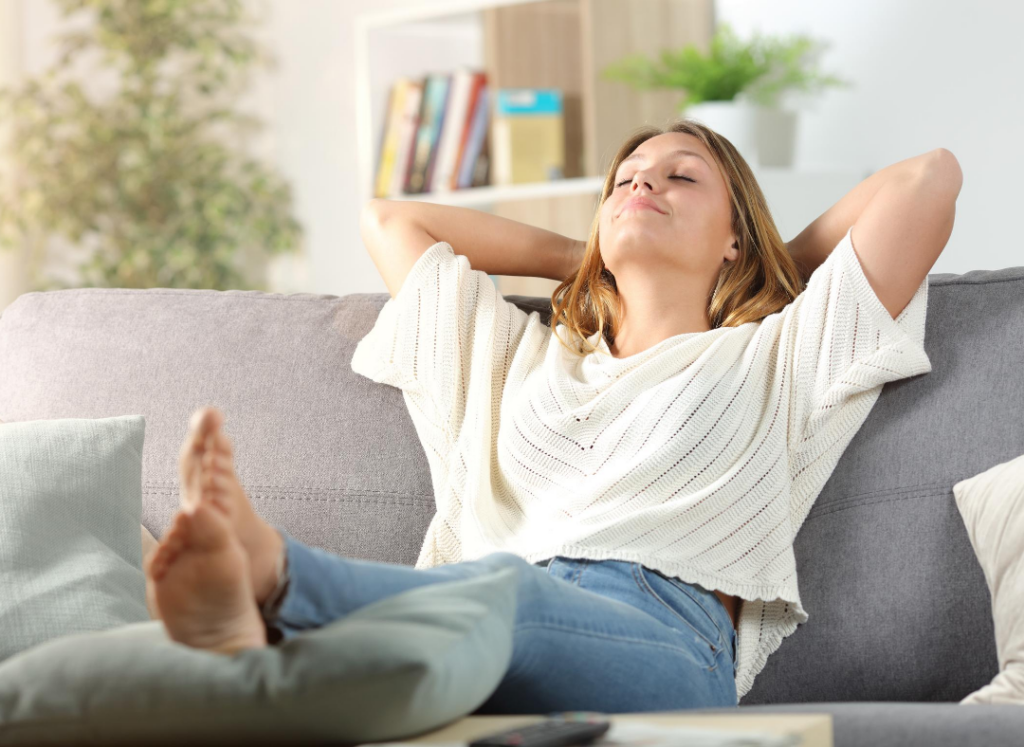
The Most Common Questions About Air Purifiers
Air purifiers are devices that clean ultrafine airborne toxins, pollutants, and allergens like smoke, pollen, mold, and dust from the air inside your home, improving indoor air quality. Unlike air filters, which remove particles from the air that passes through them, purifiers sanitize and neutralize fine airborne particles, emitting cleaned air.
At Suntech Heat and Air, we believe you and your family should feel safe, comfortable, and healthy in your home. Whether you are concerned about your home’s indoor air quality or simply want your family breathing the cleanest air possible, our trained and licensed technicians are here to help. They can determine if an air purification system is right for you, make sure it’s installed properly the first time, and even keep it functioning efficiently with reliable, routine maintenance. You can schedule an appointment online or even call or text us at (405) 785-0950.
Frequently Asked Questions
Most air purifiers are portable, designed to filter the air in a single area.
Whole-home air purifiers or cleaners, on the other hand, are devices that are installed in the house where central air can be pushed through the system before being distributed to the rest of the house.
There are three types of whole house air purifying systems:
- Stand-alone, installed into attics or closets with additional air intake and exhaust installed in the home
- Filter-based, installed in HVAC furnace systems and air intake points
- Duct-based, installed in the air duct path either before or after the central HVAC unit’s air handler
Whole-home air purification systems require professional installation and are more expensive upfront than a portable air purifier.
However, whole-house air purification systems can help clean and sanitize the air throughout your entire house. Installed into your home’s ductwork, energy-efficient whole-house air purifications systems require little maintenance other than routine inspections, operate quietly, and are virtually invisible.
Portable air purifiers are great for sanitizing the air in specific areas of your home. However, if you are concerned about the quality of your indoor air in general, or live with family members who are very sensitive to air quality, a whole-home air purification system may be your effective and cost-saving option.
Air purifiers can only remove light, ultrafine allergen particles while they’re floating in the air. They cannot remove heavier allergens like some types of mold and pollen or mites that settle to a surface before being drawn into the purifier.
While whole-home air purifiers installed in an existing HVAC system can improve air quality for the whole house, smaller, portable air purifiers can only clean the air within a designated area.
Air purifiers designed for standard household use cannot capture gaseous pollutants like carbon dioxide, volatile organic compounds (VOCs), or radon. Only air purifiers that contain PECO technology or an activated carbon filter (with the necessary amount of activated carbon) can remove VOCs, and these are typically only feasible for medical-grade settings.
Air purifiers cannot kill odor.
Additionally, your air purifier’s performance can be affected by other factors within your home, such as ventilation, open or closed windows, and how well you maintain the unit.
Air purifiers are most effective when they are used in conjunction with a high-efficiency particulate air (HEPA) filter and with other lifestyle habits that promote good indoor air quality, including:
- Never smoking inside
- Changing HVAC and other system filters every 30 to 90 days
- Maintaining the proper humidity level in your home
- Cleaning carpets, rugs, and upholstered furniture regularly
- Change out your toxic cleaning products for nontoxic substitutes
- Wash sheets and pillowcases in hot water at least once a week
- Using an exhaust fan in the kitchen, laundry, and bath
- Limit the use of indoor fireplaces and candles
Routine maintenance—such as replacing filters—and constant operation 7 days a week are also necessary to ensure the effectiveness of your home air purifier.
Because hospitals and other medical facilities are designed to care for many people, most of whom are sick with contagious illnesses, their indoor air tends to have a higher concentration of airborne contaminants, pollutants, and germs. As such, they require a higher level of air purification than the average household. Medical-grade air purification systems are specifically designed with commercial elements, like chemical adsorbent materials, that can remove chemical fumes and VOCs from the air. This makes them considerably more expensive than a standard portable air purifier for individual use.
Air purifiers can have a positive impact on the quality of your indoor air if they are used as part of an overall clean-air strategy that includes habits like regular ventilation and air circulation, routine filter maintenance, and limiting indoor use of fireplaces, candles, or tobacco.
Because today’s homes are better sealed and insulated than older homes, they can trap all of the pollutants and contaminants generated in everyday life, such as pet dander, dust, pollen, and mold. This results in indoor air that could be worse than the air outside, contributing to allergies or respiratory irritation and exacerbating conditions like asthma. If you or a family member suffer from respiratory sensitivity or are at high risk for illness, purchasing an air purifier to complement other healthy-air habits is an investment worth making.
While air purifiers can dramatically improve the presence of ultrafine airborne pollutants from your home’s air, they cannot remove CO2 (carbon dioxide) or any other gaseous molecules.
Properly maintained air purification systems that use a HEPA system, feature a sanitation function, and run continuously can be effective in removing about 99% of viruses, including COVID-19. However, the coronavirus is at the low end of a HEPA filter’s effective range, so virus particles may require several pass-throughs of the filter to be captured.
While air purifiers cannot completely eliminate viruses like COVID-19, they can be beneficial in improving the air quality for high-risk individuals in confined areas. Air purifiers can act as an additional layer of protection as part of a more comprehensive plan for clean air and sanitation.
Air purifiers that use mechanical filtration—such as a HEPA filter—are capable of trapping airborne particles like dust. These filters trap the particles either within the filter fibers or directly to the filter. However, an air purifier alone is not enough to completely eliminate dust. It will be most effective at reducing indoor dust when used in conjunction with other methods that help improve the quality of your indoor air, including cleaning upholstered and fabric furniture often, replacing carpet floors with wood or tile flooring, routine maintenance of your HVAC filters, and ensuring good air circulation.
Air purifiers can work for dust, mold, and allergies by reducing the amount of ultrafine particles in the air, but only if they are used properly and as part of a more comprehensive effort to improve indoor air quality. Removing these airborne particles can help remove the source of your allergic reactions and minimize the symptoms you experience. However, using air purifiers alone is not a substitute for allergy medications or other household cleaning habits that promote clean indoor air.
When considering buying an air purifier, there are a few things you should look for:
- HEPA filter. True HEPA filters are certified to remove at least 99.97% of ultra-fine airborne particles like dust, mold, and dander.
- Unit and room size. To work properly and effectively, the size and model of the air purifier should be designed to work in the size of the room you intend it for. To ensure quiet operation at a lower setting, select one designed to operate in a larger area than you need.
- Verified by AHAM (Association of Home Appliance Manufacturers). AHAM testing provides room size guidelines and clean air delivery rates (CADRs) for the products they test. CADRs indicate the volume (in cubic feet per minute) of clean air a purifier can produce at the highest setting. A higher CADR means the unit is faster and more efficient at cleaning the air in the designated space. Higher CADRs are necessary for removing pollutants like smoke from fireplace or tobacco use, dust, and pollen.
- Energy Star Certification. For maximum effectiveness, your air purifier needs to run constantly. Energy Star certified air purifiers are up to 40 percent more energy-efficient than other models, helping reduce their impact on your energy bill.
- Additional features like filter service indicator lights, air quality sensors, washable pre-filters, remote controls, and carrying handles or wheels that make your unit easier to use and easier to care for.
- Activated carbon filters. While some very large filters contain the several pounds of carbon granules necessary for removing odors and gaseous molecules, most household units do not, making them virtually ineffective.
- UV lamps. UV lamps are marketed to kill mold spores and bacteria, but, in reality, most models are not strong enough and do not hold the air under the light long enough to be effective on resistant strains.
- Ionizers. Ionizers attract airborne particles like static electricity. However, this process may produce ozone, a harmful gas. To avoid state bans on units that produce certain levels of ozone, some purifiers are marketed as producing “energized oxygen,” “activated oxygen,” or “super oxygen.” All of them should be avoided.
Air purifiers are more effective against asthma when they are used to complement other habits, including taking asthma medication as prescribed. By removing more ultrafine airborne particles, air purifiers can help reduce the variables that trigger asthma attacks and reduce their severity, but they are not a substitute for your asthma medication.
However, be sure to choose an air purifier that does not operate via ozone generation or ionizers. These types of air purifiers produce ozone, a gas that can cause shortness of breath, throat irritation, and coughing, and can exacerbate asthma or other breathing problems.
The best air purifiers for allergies are those that are certified by the Asthma and Allergy Foundation of America. These purifiers reduce allergens from the air, ensure ozone levels remain within federal guidelines and ensure allergens are reduced through removal, not simply redistribution.
Purifiers that use a HEPA filter will also be the most effective in reducing pollutants and particles that exacerbate allergies.

